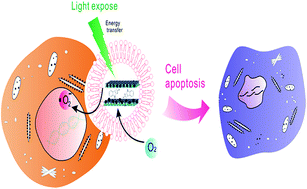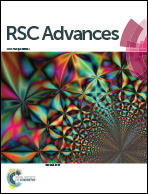Hierarchical coated metal hydroxide nanoconstructs as potential controlled release carriers of photosensitizer for skin melanoma†
Abstract
Inorganic nanostructured ensembles containing an anionic clay matrix with layered double hydroxide (LDH) were designed in nanooncology for photosensitizer delivery. A core–shell strategy was combined with host–guest chemistry by the intercalation of indole-3-acetic acid (IAA). This single formulation, with good drug loading percentage and a compact liposome coating (LDH–IAA–Lipo) over and around the positively charged layered surface establishes a controlled release property for the treatment of skin melanoma. All the data regarding synthesis, physical characterization, chemical stability by thermogravimetric analysis and coat stability by leaching test in solvent mixture containing triton X-100 and biological buffer was obtained. IAA was estimated using high-performance liquid chromatography (HPLC) under optimized conditions with an admirable outcome. An improvement in cytotoxic properties under visible light exposure has been confirmed by MTT, ROS levels, DNA fragmentation using comet assay and apoptosis by analysis of mitochondrial membrane potential (MMP) using the MitoProbe JC-1 assay. In contrast, this formulation depicted cytocompatibility in a normal fibroblast (3T3) cell line. Photodynamic therapy (PDT) can be suggestible for long term therapy since the combinatorial efficiency of drug molecules in addition to light irradiation was dramatically evidenced to treat melanoma effectively.


 Please wait while we load your content...
Please wait while we load your content...